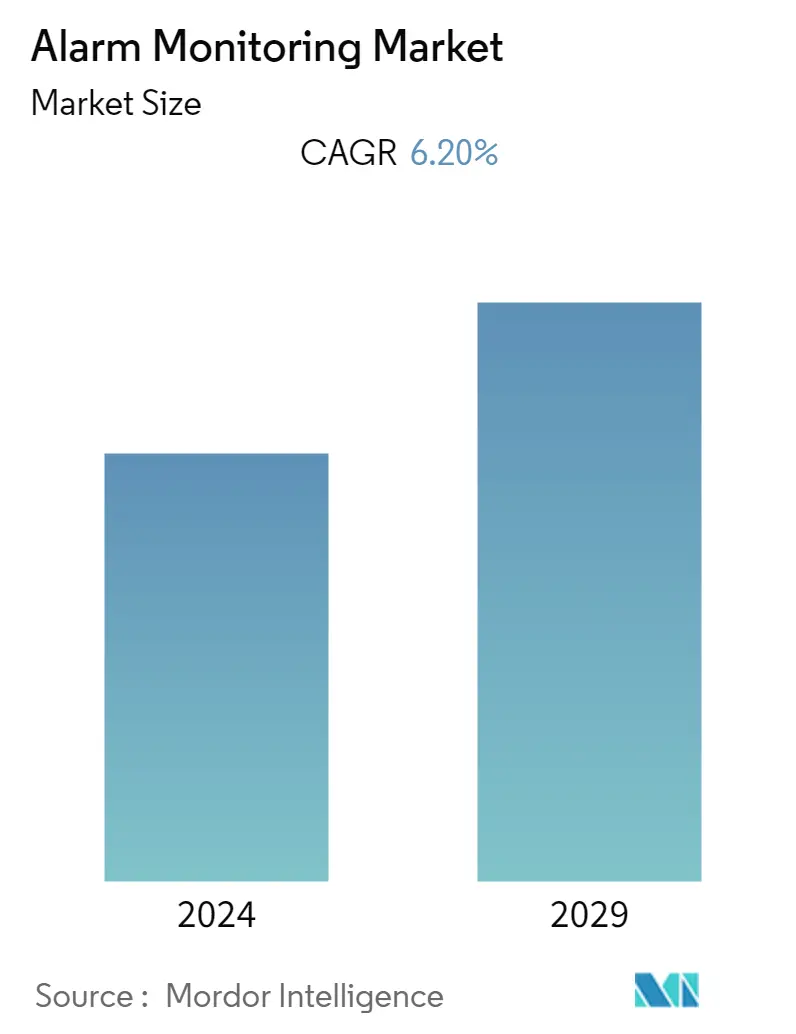Market Size of Alarm Monitoring Industry

| Study Period | 2019 - 2029 |
| Base Year For Estimation | 2023 |
| CAGR | 6.20 % |
| Fastest Growing Market | Asia Pacific |
| Largest Market | North America |
| Market Concentration | Medium |
Major Players
*Disclaimer: Major Players sorted in no particular order |
Alarm Monitoring Market Analysis
The Alarm Monitoring Market is expected to grow at a CAGR of 6.2% over the forecast period. An increase in crime rate and increasing adoption of security systems that comes with insurance policies for residential and commercial applications are the major factors that are driving the growth of the global alarm monitoring market.
- Numerous technological advancements, especially in communications technology, led to a transition from traditional monitoring over telephone lines to monitoring systems that exploit digital, wireless, and cellular communications to provide better, more reliable, and more convenient monitoring to consumers. Moreover, with the advent of the Internet of Things, common household objects are increasingly being connected to the internet, enabling them to transmit and receive different data types.
- Security system technology is constantly evolving, and newer technologies are continuously innovated to improve the security of business security systems through the constant augmentation of camera processors and alarm sensors that feature an extensive suite of new alerts and smart features that make using these systems easier. These new features and technologies are making the security of homes and commercial buildings more effective, thereby driving the growth of the studied market.
- Moreover, the integration of security systems in mobiles gained popularity in the last few years, and smart features are becoming more integral to home and commercial security efforts. While remote monitoring via mobile devices and the ability to arm or disarm a system remotely was popular for quite some time, multiple systems and manufacturers are integrating additional features, such as alarm triggers and panic buttons, into their mobile apps. This enables the home and commercial system users to trigger the alarm and alert the monitoring station of potential emergencies from their mobile devices.
- Smart cities are growing globally, and urbanization is enabling their growth. According to the United Nations, the proportion of people living in urban areas is expected to increase to 66% by 2050. According to the projections provided by the United Nations, in multiple countries, such as India (404 million), China (292 million), and Nigeria (212 million), urban dwellers are expected to increase in number by 2050. Increased spending on smart cities, technological developments, urbanization, and government support and funding are leading to an increased number of smart city projects. Technology led to the growth in the use of video surveillance cameras in smart buildings to prevent crimes. The new Data Protection Law is more demanding and guarantees people's privacy. This is expected to influence the demand for the alarm monitoring market over the forecast period.
- The development of smart cities needs to be complemented by the adoption of security measures by equally invested public institutions, such as schools, colleges, and banks. In September 2021, Aalborg University in Denmark installed a security system featuring intrusion alarms, video monitoring systems, and access software that utilize access cards for any individual across all its buildings. All the data was strategized to be protected on campus, in the university's private servers, and managed from a central control facility in Aarhus, where a centralized security platform is used to monitor video footage and alarm systems. Furthermore, their decision to install the system allowed them to fit environmental sensors to keep track of any relevant metrics across the campus. To complete the installation, security professionals from G4S patrol the premises with a tablet device that acts as a portal into the monitoring software, providing instant alerts in case of emergencies.
- Moreover, the recent outbreak of the COVID-19 pandemic is completely different from any previous recessions. It impacted consumer spending, and the forced mass quarantines inundated almost every country worldwide. The consumer's propensity to adopt security solutions is on the rise due to the pandemic. The aspect of a 'smart building' looks more practical in the new normal post-COVID-19.
Alarm Monitoring Industry Segmentation
Alarm monitoring is a process of communicating quickly between the security systems and the central station of the security provider. The system offers services to detect fire, burglary, and residential alarm systems. The alarm monitoring system records an emergency event and accordingly sends signals to the central monitoring system. After receiving the signals, the appropriate authorities are then sent to the location to tackle the emergency. These monitoring systems use radio channels, computers, telephones, and trained staff to monitor the security system of the customers and reciprocate it to the authorities.
The Alarm Monitoring Market is segmented by Offering (Hardware, Software, Services), Communication Technology (Wired Telecommunication Network, Cellular Wireless Network, Wireless Radio Network and, IP Network), Application (Building Alarm Monitoring, Vehicle Alarm Monitoring), and Geography.
| By Offering | ||||||
| ||||||
| Software | ||||||
| Services (Monitoring Services, Installation Services) |
| By Communication Technology | |
| Wired Telecommunication Network | |
| Cellular Wireless Network | |
| Wireless Radio Network | |
| IP Network |
| By Application | |
| Vehicle Alarm Monitoring | |
| Building Alarm Monitoring | |
| Other Applications |
| By Geography | |
| North America | |
| Europe | |
| Asia Pacific | |
| Middle East and Africa | |
| Latin America |
Alarm Monitoring Market Size Summary
The alarm monitoring market is poised for significant growth, driven by increasing crime rates and the rising adoption of security systems integrated with insurance policies for both residential and commercial applications. Technological advancements, particularly in communications, have facilitated a shift from traditional monitoring methods to more sophisticated digital, wireless, and cellular systems, enhancing reliability and convenience for consumers. The integration of the Internet of Things (IoT) has further transformed security systems, allowing everyday objects to connect to the internet, thereby improving data transmission and reception. This evolution in technology has led to the development of smarter security features, such as advanced camera processors and alarm sensors, which are making home and commercial security more effective. The growing trend of smart cities, supported by urbanization and government initiatives, is also contributing to the market's expansion, as these cities increasingly rely on technology for crime prevention and safety.
In the United States, the alarm monitoring market is expected to lead in the North American region, fueled by stringent government regulations and the high adoption of advanced technologies. The country's robust investments in commercial buildings and its well-established emergency response infrastructure further bolster market growth. Despite these advantages, the prevalence of fire incidents highlights the need for advanced IoT-based solutions. The market is moderately fragmented, with key players engaging in strategies such as expansions, partnerships, and new product launches to strengthen their market position. Recent developments include the introduction of enhanced alarm monitoring systems and cybersecurity services, as well as collaborations to improve public safety in various settings. These efforts reflect the industry's commitment to addressing evolving security challenges and meeting the growing demand for integrated monitoring solutions.
Alarm Monitoring Market Size - Table of Contents
-
1. MARKET INSIGHTS
-
1.1 Market Overview
-
1.2 Industry Value Chain Analysis
-
1.3 Industry Attractiveness - Porter's Five Forces Analysis
-
1.3.1 Bargaining Power Of Suppliers
-
1.3.2 Bargaining Power Of Buyers
-
1.3.3 Threat Of New Entrants
-
1.3.4 Threat Of Substitutes
-
1.3.5 Intensity Of Competitive Rivalry
-
-
1.4 Impact of COVID-19 on the Market
-
-
2. MARKET SEGMENTATION
-
2.1 By Offering
-
2.1.1 Hardware
-
2.1.1.1 Remote Terminal Units (RTUS)
-
2.1.1.2 Alarms Sensor
-
2.1.1.3 Communication Networks and Gateways
-
2.1.1.4 Other Hardware
-
-
2.1.2 Software
-
2.1.3 Services (Monitoring Services, Installation Services)
-
-
2.2 By Communication Technology
-
2.2.1 Wired Telecommunication Network
-
2.2.2 Cellular Wireless Network
-
2.2.3 Wireless Radio Network
-
2.2.4 IP Network
-
-
2.3 By Application
-
2.3.1 Vehicle Alarm Monitoring
-
2.3.2 Building Alarm Monitoring
-
2.3.3 Other Applications
-
-
2.4 By Geography
-
2.4.1 North America
-
2.4.2 Europe
-
2.4.3 Asia Pacific
-
2.4.4 Middle East and Africa
-
2.4.5 Latin America
-
-
Alarm Monitoring Market Size FAQs
What is the current Alarm Monitoring Market size?
The Alarm Monitoring Market is projected to register a CAGR of 6.20% during the forecast period (2024-2029)
Who are the key players in Alarm Monitoring Market?
ABB Ltd., Siemens AG, Rockwell Automation Inc., Honeywell International Inc. and Schneider Electric SE are the major companies operating in the Alarm Monitoring Market.

